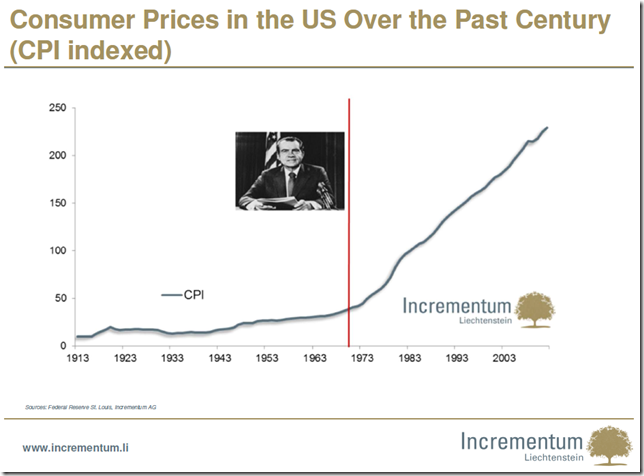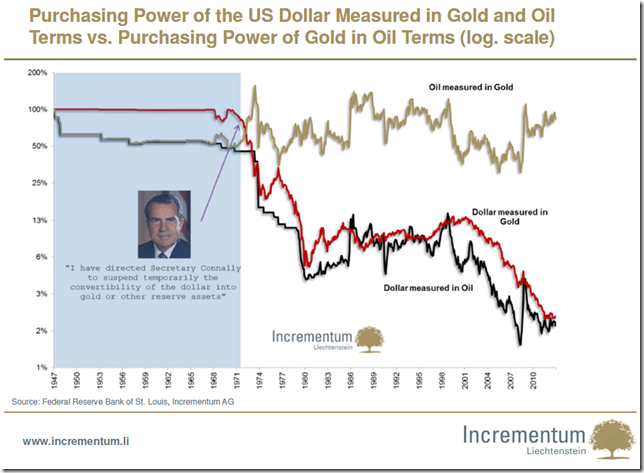Via Zero Hedge:
Bill, in a comment here, says, “a 1911 costs essentially the same, in gold, as it did in 1911, and 1945, and 1960, and 2000.”
I’m not sure what conclusions can be drawn from this other than holding onto dollars is a futile attempt to retain wealth.



Same with a car. I read that a Model-T, if paid for in gold, costs the same as a modern sedan, if also paid for in gold.
Obviously one should buy 1911s as an inflation hedge. More useful than gold.
Also more regulated. Diversify. Some base metal, some precious metals. Some plastic guns, some steel guns. Some long guns, some hand guns. And lots and lots of gun food.
My grandmother bought a farm with a couple hundred acres for five gold coins (about $100). These gold/inflation charts don’t hold true for land.
This is due to a number of factors that cannot be controlled by the typical owner. There are more uncontrollable factors that can cause loss of value, than there are ones that enhance value. Population changes, technology, weather, water availability, civil unrest, war, pests, plant damaging/killing organisms, are just some of the potential problems.
Don’t forget zoning and regulations. In Hawaii for example, much of the already-in-short-supply land is tied up in national parks and preserves, which drives up the price of the real estate that is available for development. Zoning, regulation and the cost of commuting in time and in money cause city land to be way more expensive than country land.
Then again, gold has been confiscated by a Constitutution-stomping president, and guns have not (yet).
I forgot who it was that mentioned this — Ludwig von Mises, Thomas Hazlitt, Neil Smith? — that the track record for gold goes back much further. A good quality suit of dress clothing costs the same, in gold, as it did for a Roman in the time of Caesar.
What is unmentioned when ever these sorts of things get posted is that up until 1973 gold was kept at an artificially low price of $35.00 per once. Comparing things to gold prior to 1973 is highly disingenuous, as the price of gold didn’t move for decades and the nearly flat CPI was a result of that market distortion.
Was gold really pegged at an artifically low price of $35, or was the dollar pegged at an artifically high value to gold?
The unit quantity of currency is abstract and meaningless, it’s only requirement is that it be easily represenative on a scale from penny candy to sports star contracts. When you no longer can find a gumball or soda machine that takes a single coin, and nearly all prices end in .95 or .99 mean the currency is too precice for it’s own good.
A currency is both a medium of exchange and a store of value. The charts don’t show “distortion”, they show the change in the currency’s store of value over time.
As I recall, after the 1933 bank holiday, and as part of FDR’s wholesale reordering of the economy, his National Recovery Association set the minimum wage to 25 cents an hour (up from 10-15 cents) and also set the price the US would buy gold at as $35, up from $19.
Nothing artificial about it — it was merely what the dollar was pegged to.
A dollar was defined as simply being worth exactly 1/35th of an ounce of gold. Period.
It’s no more “artificial” than when they stated that a kilogram was the mass of a liter of water.
The word you are looking for is “arbitrary”, which is not (despite the modern assumption) a derogatory term, merely a descriptive one. ANY hard currency is simply defined by finding a particular (and objectively definable) item of value and picking an arbitrary quantity to define your unit of currency.
The post-1973 dollar is not really directly comparable to pre-1973 dollars, because the current dollar is wholly a fiat currency. (And, again, “fiat” is not a derogatory term — it is a descriptive one. There are disadvantages to both monetary policies — hard currencies are inflexible, which can create HUGE problems in an economy that is either expanding or contracting; fiat currencies are flexible enough to adapt, but are invariably abused and turned into Monopoly money eventually by overprinting.)
Actually, the “peg” of 1973 is a lie. There was in fact no such thing. No one could buy gold at that price. It was less real than the Venezuelan official exchange rate.
If you want to look at meaningful exchange rates of dollars vs. gold, you have to go back to the last time that a normal person could walk into a bank and demand gold for his paper dollar. That ability was abolished (as it had to be) early in the days of the Federal Reserve, and finally killed for good by that old Constitution-trampler FDR when he stole all the privately owned gold.
So in reality, the dollar has been a fiat currency ever since that time, in spite of the well-propagandized fiction of the gold peg. See Ludwig von Mises (for example, “Human Action”) and Henry Hazlitt (“From Bretton Woods to World Inflation”) for details. And yes, “fiat money” is most definitely a derogatory term, at least among those who have a decent understanding of real economics. (For this too, see those two books and others by those authors, for example “Economics in One Lesson”.)
No, fiat currency is NOT always a derogatory term — even to those who undertand economics.
As with medicine, the difference between poison and medicine is dosage and use. Heroin and cocaine, used appropriately, are very good medicines for some situations. Heroin and cocaine, used routinely, are really bad ideas. Heroin and cocaine, used for non-medicinal purposes, are dangerously stupid ideas.
There are situations where a hard currency is as damaging to the economy as a fiat currency is in others — the difference is that it’s easier to screw up a fiat currency.
But you can screw up an economy and smother it in its bed just as easily by NOT utilizing a fiat currency in certain circumstances. If the supply of hard currency is significantly smaller than the actual total wealth of the economy, you have very big problems. BY DEFINITION, you cannot magically whip up more hard currency — and substituting a second “hard” currency (such as bimetallism) invokes Gresham’s Law just as truly as a flat fiat currency. . . only you ALSO have to come up with the hard store of value. . . the “Free Silver” guys were just as crazy and ill-informed as the pure fiat currency guys.
The trick is to realize that fiat currency is best suited for limited duration use for specific types of unusual circumstances, and needs to be deliberately removed from the money supply as quickly as possible afterwards.
Fiat currency is ALWAYS inflationary — but sometimes, that’s better than the alternative.
Hard currency is ALWAYS deflationary in a growing economy — but generally that’s better than the alternative.
The problem is in thinking fiat currency is appropriate for normal, everyday situations. Likewise, assuming that hard currency monetary policies are always appropriate.
“There are situations where a hard currency is as damaging to the economy as a fiat currency is in others” — I doubt that.
How about giving an example to support that assertion? And no, the Great Depression does not qualify — hard currency no longer existed by then.
Oh by the way, of course hard currency is deflationary. That’s normal, expected, and healthy. It follows from the fact that productivity increases.
There’s a bizarre notion in many places that deflation is always bad, which produces such monstrosities as a “target” for the inflation rate. Yes, deflation can be caused by economic collapse which in turn is often caused by fiat currency mismanagement, but the fact that price collapse is a sign of a busted economy does not mean that the gradual deflation produced by improved productivity of goods priced with hard currency is in any way a problem.
Not only is such gradual deflation normal and healthy, it is itself an economic benefit — consider what it does for people who hold savings accounts (in real money).